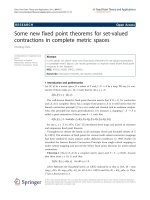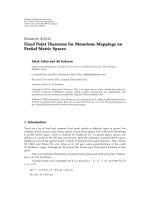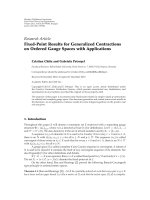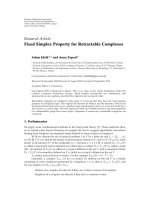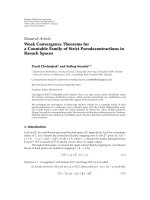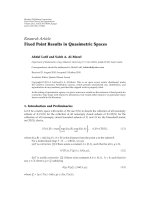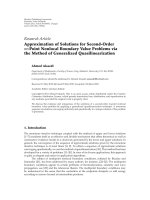Báo cáo hóa học: " Research Article Fixed Point Theorems for n Times Reasonable Expansive Mapping" pptx
Bạn đang xem bản rút gọn của tài liệu. Xem và tải ngay bản đầy đủ của tài liệu tại đây (463.35 KB, 6 trang )
Hindawi Publishing Corporation
Fixed Point Theory and Applications
Volume 2008, Article ID 302617, 6 pages
doi:10.1155/2008/302617
Research Article
Fixed Point Theorems for n Times Reasonable
Expansive Mapping
Chunfang Chen and Chuanxi Zhu
Institute of Mathematics, Nanchang University, Nanchang, Jiangxi 330031, China
Correspondence should be addressed to Chuanxi Zhu,
Received 29 February 2008; Revised 3 May 2008; Accepted 16 August 2008
Recommended by Jerzy Jezierski
Based on previous notions of expansive mapping, n times reasonable expansive mapping is
defined. The existence of fixed point for n times reasonable expansive mapping is discussed and
some new results are obtained.
Copyright q 2008 C. Chen and C. Zhu. This is an open access article distributed under the Creative
Commons Attribution License, which permits unrestricted use, distribution, and reproduction in
any medium, provided the original work is properly cited.
1. Introduction and preliminaries
The research about fixed points of expansive mapping was initiated by Machuca see 1.
Later, Jungck discussed fixed points for other forms of expansive mapping see 2. In 1982,
Wang et al. see 3 published a paper in Advances in Mathematics about expansive mapping
which draws great attention of other scholars. Also, Zhang has done considerable work in this
field. In order to generalize the results about fixed point theory, Zhang see 4 published his
work Fixed Point Theory and Its Applications, in which the fixed point problem for expansive
mapping is systematically presented in a chapter. As applications, he also investigated the
existence of solutions of equations for locally condensing mapping and locally accretive
mapping. In 1991, based on the results obtained by others, the author defined several new
kinds of expansive-type mappings in 5, which expanded the expansive-type mapping from
19 to 23, and gave some new applications. Recently, the study about fixed point theorem for
expansive mapping and nonexpansive mapping is deeply explored and has extended too
many other directions. Motivated and inspired by the works see 1–13,inthispaper,we
define n times reasonable expansive mapping and discuss the existence of fixed point for
n times reasonable expansive mapping. For the sake of convenience, we briefly recall some
definitions.
Let X, d be a complete metric space and let T : X → X be a mapping.
Throughout this paper, we use N to denote the set of natural numbers and x to
denote the maximum integral value that is not larger than x.
2 Fixed Point Theory and Applications
T : X → X is called an expansive mapping if there exists a constant h>1 such that
dTx,Ty ≥ hdx, y, for all x,y ∈ X.
T : X → X is called a two times reasonable expansive mapping if there exists a constant
h>1 such that dx, T
2
x ≥ hdx, Tx, for all x ∈ X.
T : X → X is called a twenty-one type expansive mapping if there exists a constant
h>1 such that
dTx,Ty ≥ h min
dx, y,dx, Tx,dy,Ty,dx, Ty,dy, Tx
, ∀x, y ∈ X. 1.1
T : X → X is called a twenty-three type expansive mapping if there exists a constant
h>1 such that
d
2
Tx,Ty ≥ h min
d
2
x, y,dx, y·dx, Tx,dx, Tx·dy, Ty,
d
2
x, Tx,dy,Ty·dx, Ty,dy, Ty·dy, Tx
, ∀x, y ∈ X.
1.2
2. Main results
Definition 2.1. Let X, d be a complete metric space. T : X → X is called an n n ≥ 2,n∈ N
times reasonable expansive mapping if there exists a constant h>1 such that
d
x, T
n
x
≥ hdx, Tx, ∀x ∈ X n ≥ 2,n∈ N. 2.1
Definition 2.2. Let X, d be a complete metric space. T : X → X is called an H
1
-type n n ≥
2,n∈ N times reasonable expansive mapping if there exists a constant h>1 such that
d
T
n−1
x, T
n−1
y
≥ h min
dx, y,dx, Tx,d
T
n−2
y, T
n−1
y
,
d
x, T
n−1
y
,d
T
n−2
y, T
n−1
x
, ∀x, y ∈ X n ≥ 2,n∈ N.
2.2
Definition 2.3. Let X, d be a complete metric space. T : X → X is called an H
2
-type n n ≥
2,n∈ N times reasonable expansive mapping if there exists a constant h>1 such that
d
2
T
n−1
x, T
n−1
y
≥ h min
d
2
x, y,dx, y·dx, Tx,dx, Tx·d
T
n−2
y, T
n−1
y
,d
2
x, Tx,
d
T
n−2
y, T
n−1
y
·d
x, T
n−1
y
,d
T
n−2
y, T
n−1
y
·d
T
n−2
y, T
n−1
x
,
∀x, y ∈ X n ≥ 2,n∈ N.
2.3
Lemma 2.4 see 6. Let X, d be a complete metric space, let A be a subset of X, and let the
mappings f, g : A → X satisfy the following conditions:
i f is a surjective mapping fAX;
ii there exists a functional ϕ : X → R which is lower semicontinuous bounded from below
such that dfx,gx ≤ ϕfx − ϕgx, for all x ∈ A.
Then, f and g have a coincidence point, that is, there exists at least an x
∈ A such that
fxgx.
Especially, if one lets A X, g I
X
(the identity mapping on X), then f has a fixed point
in X.
C. Chen and C. Zhu 3
Theorem 2.5. Let X, d be a complete metric space and let T : X → X be a continuous and surjective
mapping if there exists a constant h>1 such that
d
T
n−1
x, T
n
x
≥ hdx, Tx, ∀x ∈ X n ≥ 2,n∈ N. 2.4
Then, T has a fixed point in X.
Proof. By 2.4, we have
d
T
n−1
x, T
n
x
− dx, Tx ≥ hdx, Tx − dx, Tx, ∀x ∈ X. 2.5
Thus,
dx, Tx ≤
1
h − 1
d
T
n−1
x, T
n
x
− dx, Tx
, ∀x ∈ X. 2.6
Let ϕx1/h − 1dT
n−1
x, T
n−2
xdT
n−2
x, T
n−3
x··· dT
2
x, TxdTx,x.
Then we have dx, Tx ≤ ϕTx−ϕx, for all x ∈ X. From the continuity of d, we know
that ϕx is continuous. Thus ϕx is lower semicontinuous bounded from below. Therefore
the conclusion follows immediately from Lemma 2.4.
Theorem 2.6. Let X, d be a complete metric space and let T : X → X be a continuous and surjective
n n ≥ 2,n∈ N times reasonable expansive mapping. Assume that either (i) or (ii) holds:
i T is an H
1
-type n times reasonable expansive mapping;
ii T is an H
2
-type n times reasonable expansive mapping.
Then, T has a fixed point in X.
Proof. In the case of i, taking y Tx in 2.2, we have
d
T
n−1
x, T
n
x
≥ h min
dx, Tx,dx, Tx,d
T
n−1
x, T
n
x
,d
x, T
n
x
,d
T
n−1
x, T
n−1
x
h min
dx, Tx,d
T
n−1
x, T
n
x
,d
x, T
n
x
.
2.7
Because T is an n times reasonable expansive mapping, we have
d
x, T
n
x
≥ hdx, Tx >dx, Tx. 2.8
Thus, we obtain
d
T
n−1
x, T
n
x
≥ h min
dx, Tx,d
T
n−1
x, T
n
x
. 2.9
If dT
n−1
x, T
n
xmin{dx, Tx,dT
n−1
x, T
n
x}, then dT
n−1
x, T
n
x ≥ hdT
n−1
x, T
n
x.
Hence, dT
n−1
x, T
n
x0 otherwise, dT
n−1
x, T
n
x >dT
n−1
x, T
n
x, which is a
contradiction. Therefore, T
n−1
x T
n
x, that is T
n−1
x TT
n−1
x, which implies that T
n−1
x
is a fixed point of T in X.
If dx, Txmin{dx, Tx,dT
n−1
x, T
n
x}, then dT
n−1
x, T
n
x ≥ hdx, Tx.
By Theorem 2.5,weobtainthatT has a fixed point in X.
4 Fixed Point Theory and Applications
In the case of ii, taking y Tx in 2.3, we have
d
2
T
n−1
x, T
n
x
≥ h min
d
2
x, Tx,dx, Tx·dx, Tx,dx, Tx·d
T
n−1
x, T
n
x
,
d
2
x, Tx,d
T
n−1
x, T
n
x
·d
x, T
n
x
,d
T
n−1
x, T
n
x
·d
T
n−1
x, T
n−1
x
h min
d
2
x, Tx,dx, Tx·d
T
n−1
x, T
n
x
,d
T
n−1
x, T
n
x
·d
x, T
n
x
.
2.10
Because T is an n n ≥ 2,n∈ N times reasonable expansive mapping, we have
d
x, T
n
x
≥ hdx, Tx >dx, Tx . 2.11
Hence, dx, T
n
x·dT
n−1
x, T
n
x >dx, Tx·dT
n−1
x, T
n
x.
Therefore, we have
d
2
T
n−1
x, T
n
x
≥ h min
d
2
x, Tx,dx, Tx·d
T
n−1
x, T
n
x
. 2.12
If d
2
x, Txmin{d
2
x, Tx,dx, Tx·dT
n−1
x, T
n
x}, then
d
2
T
n−1
x, T
n
x
≥ hd
2
x, Tx ∀x ∈ X, 2.13
that is, dT
n−1
x, T
n
x ≥
√
hdx, Tx.
Because
√
h>1, by Theorem 2.5,weobtainthatT has a fixed point in X.
If dx, Tx·dT
n−1
x, T
n
xmin{d
2
x, Tx,dx, Tx·dT
n−1
x, T
n
x}, then d
2
T
n−1
x,
T
n
x ≥ hdx, Tx·dT
n−1
x, T
n
x,thatis
d
T
n−1
x, T
n
x
·
d
T
n−1
x, T
n
x
− hdx, Tx
≥ 0. 2.14
If dT
n−1
x, T
n
x0, then T
n−1
x T
n
x, that is T
n−1
x TT
n−1
x, which implies that
T
n−1
x is a fixed point of T in X.
If dT
n−1
x, T
n
x
/
0, then dT
n−1
x, T
n
x ≥ hdx, Tx. By Theorem 2.5,weobtainthatT
has a fixed point in X.
Therefore, by induction we derive that T has a fixed point in X.
Corollary 2.7. Let X, d be a complete metric space. If T : X → X is a continuous and surjective
twenty-one type expansive mapping and T : X → X is a two times reasonable expansive mapping,
then T has a fixed point in X.
Proof. We denote y T
o
y; taking n 2 under the condition i of Theorem 2.6, Corollary 2.7
is proved immediately.
Similarly, we denote y T
o
y; taking n 2 under the condition ii of Theorem 2.6,we
can obtain the following Corollary 2.8.
Corollary 2.8. Let X, d be a complete metric space. If T : X → X is a continuous and surjective
twenty-three type expansive mapping and T : X → X is a two times reasonable expansive mapping,
then T has a fixed point in X.
Remark 2.9. Corollaries 2.7 and 2.8 are Theorems 2.3 and 2.5 in 5, respectively. Thus,
Theorems 2.3 and 2.5 in 5 are the special examples of Theorem 2.6.
C. Chen and C. Zhu 5
Theorem 2.10. Let X, d be a complete metric space and let T : X → X be a continuous and
surjective n n ≥ 2,n∈ N times reasonable expansive mapping. If there exists a constant h>1 such
that
d
T
n
x, T
n
y
≥ h min
dx, y,d
y, T
n
y
, ∀x, y ∈ X n ≥ 2,n∈ N , 2.15
then T has a fixed point.
Proof. Letting x Ty in 2.15, we have
d
T
n1
y, T
n
y
≥ h min
dTy,y,d
y, T
n
y
, ∀y ∈ X. 2.16
Since T is an n n ≥ 2,n∈ N times reasonable expansive mapping, then
d
y, T
n
y
≥ hdy, Ty >dy,Ty, ∀y ∈ X. 2.17
By 2.16 and 2.17, we have dT
n1
y, T
n
y ≥ hdTy,y for all y ∈ X.
It follows from Theorem 2.5 that T has a fixed point in X.
Remark 2.11. Generally speaking, n n ≥ 2,n∈ N times reasonable expansive mapping does
not necessarily have a fixed point. This can be illustrated by the following examples.
Example 2.12. We denote by B
1
the unit circle which takes the original point as its center and
1 as its radius on the complex plane, that is, B
1
{Z ||Z| 1,Z∈ C}. B
1
can also be written
as {e
iθ
| e
iθ
∈ C, −∞ <θ<∞}. Suppose that T : B
1
→ B
1
is a mapping defined as follows:
TZ Te
iθ
e
iθ2π/3n
. 2.18
For every Z ∈ B
1
, that is, Z e
iθ
, we have
TZ Te
iθ
e
iθ2π/3n
,
T
2
Z TTZT
Te
iθ
Te
iθ2π/3n
e
iθ22π/3n
,
···
T
k
Z e
iθk2π/3n
,
···
T
n
Z e
iθn2π/3n
e
iθ2π/3
.
2.19
From the above equations, we obtain
d
Z, T
n
Z
T
n
Z − Z
e
iθ2π/3
− e
iθ
e
iθ
·
e
i2π/3
− 1
cos
2π
3
i sin
2π
3
− 1
−
1
2
√
3
2
i − 1
√
3,
dZ, T Z|TZ −Z|
e
iθ2π/3n
− e
iθ
e
iθ
·
e
i2π/3n
− 1
cos
2π
3n
i sin
2π
3n
− 1
2 − 2 cos
2π
3n
2
sin
2
π
3n
2sin
π
3n
n ≥ 2,n∈ N .
2.20
6 Fixed Point Theory and Applications
Since n ≥ 2, then sinπ/3n ≤ 1/2. Thus dZ, T
n
Z/dZ, T Z ≥
√
3, for all Z ∈ B
1
,that
is, dZ, T
n
Z ≥
√
3dZ, T Z, for all Z ∈ B
1
. We can take a constant h
√
3, which means that
there exists a constant h>1 such that dZ, T
n
Z ≥ hdZ, T Z, for all Z ∈ B
1
n ≥ 2,n∈ N.
Therefore, T is an n times reasonable expansive mapping. Since e
iθ
/
e
iθ2π/3
, then TZ
/
Z,
for all Z ∈ B
1
. It implies that T does not have a fixed point.
Example 2.13. Suppose that T : R → R is a mapping defined as Tx x 1.
It is obvious that T is continuous and surjective and T does not have a fixed point.
Now, we prove T is an n times reasonable expansive mapping.
In fact, by the definition of T, we have T
n
x x n n ≥ 2,n∈ N .
Because dx, T
n
x|x n − x| n ≥ 2anddx, Tx|x 1 − x| 1, we have
dx, T
n
x ≥ 2dx, Tx. Thus, we can take a constant h 2, which means that there exists a
constant h>1 such that dx, T
n
x ≥ hdx, Tx, for all x ∈ R n ≥ 2,n∈ N .
Therefore, T is an n times reasonable expansive mapping.
Acknowledgments
This work was supported by the National Natural Science Foundation of China 10461007
and 10761007 and the Provincial Natural Science Foundation of Jiangxi, China 0411043 and
2007GZS2051.
References
1 R. Machuca, “A coincidence theorem,” The American Mathematical Monthly, vol. 74, no. 5, p. 569, 1967.
2 G. Jungck, “Commuting mappings and fixed points,” The American Mathematical Monthly, vol. 83, no.
4, pp. 261–263, 1976.
3 S. Wang, B. Li, and Z. Gao, “Expansive mappings and fixed-point theorems for them,” Advances in
Mathematics, vol. 11, no. 2, pp. 149–153, 1982 Chinese.
4 S. Zhang, Fixed Point Theory and Its Applications, Chongqing Press, Chongqing, China, 1984.
5 C. Zhu, “Several new mappings of expansion and fixed point theorems,” Journal of Jiangxi Normal
University, vol. 15, no. 8, pp. 244–248, 1991 Chinese.
6 S. Park, “On extensions of the Caristi-Kirk fixed point theorem,” Journal of the Korean Mathematical
Society, vol. 19, no. 2, pp. 143–151, 1983.
7 C. Zhu, “Several nonlinear operator problems in the Menger PN space,” Nonlinear Analysis: Theory,
Methods & Applications, vol. 65, no. 7, pp. 1281–1284, 2006.
8 D. Guo, Nonlinear Functional Analysis, Shandong Science and Technology Press, Jinan, China, 1985.
9 C. Zhu and Z. Xu, “Several problems of random nonlinear equations,” Acta Analysis Functionalis
Applicata, vol. 5, no. 3, pp. 217–219, 2003 Chinese.
10 C. Zhu, “Generalizations of Krasnoselskii’s theorem and Petryshyn’s theorem,” Applied Mathematics
Letters, vol. 19, no. 7, pp. 628–632, 2006.
11 C. Zhu and Z. Xu, “Random ambiguous point of random kω-set-contractive operator,” Journal of
Mathematical Analysis and Applications, vol. 328, no. 1, pp. 2–6, 2007.
12 C. Zhu and X. Huang, “The topological degree of A-proper mapping in the Menger PN-space—II,”
Bulletin of the Australian Mathematical Society, vol. 73, no. 2, pp. 169–173, 2006.
13 C. Zhu and Z. Xu, “A class of random operator equations in the Hilbert space,”
Acta Mathematica
Sinica, vol. 47, no. 4, pp. 641–646, 2004 Chinese.
